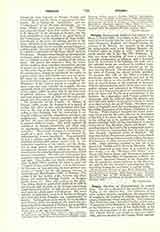

Peruzzi , BALDASSARE, architect and painter, b. at Siena, March 7, 1481; d. at Rome, January 6, 1537. He derived much benefit from the years of apprenticeship under Bramante, Raphael, and Sangallo during the erection of St. Peter’s. An evidence of his genius for independent work is the Palazzo Massimi alle Colonne, which he began in 1535. Almost all art critics ascribe also to him the Villa Farnesina. In this, two wings branching off from a central hall, a simple arrangement of pilasters, and a beautiful frieze on the exterior of the building, airy halls, and a few splendid rooms are combined in excellent taste. The paintings which adorn the interior are for the most part by Peruzzi. The decoration of the facade, the work of Peruzzi, has almost entirely perished. To decorate this villa on the Tiber a number of second-rate artists were employed, and just as the style of the villa in no wise recalls the old castellated type of country-house, so the paintings in harmony with the pleasure-loving spirits of the time were thoroughly antique and uninspired by Christian ideas. It seems that Raphael designed the composition of the story of Amor and Psyche as a continuation of the Galatea. On a plate-glass vault Peruzzi painted the firmament, with the zodiacal signs, the planets, and other heavenly bodies, his perspective being so skillful as to deceive even the eye of Titian. The close proximity of Raphael‘s work has overshadowed Peruzzi in the ceiling decoration of the Stanza d’Eliodoro in the Vatican. While Raphael designed the mural paintings and, it may be, the entire plan for the decoration of the hall, it is certain that the tapestry-like frescoes on the ceiling are to be ascribed to Peruzzi. Four scenes represent God‘s saving omnipotence as shown in the case of Noe, Abraham, Jacob, and Moses. The manifestation of the Lord in the burning bush and the figure of Jehovah commanding Noe to enter the ark were formerly considered works of Raphael. But some time before, Peruzzi had produced for the church of S. Croce in Gierusalemme a mosaic ceiling, the beautiful keystone of which represented the Savior of the world. Other paintings ascribed to him are to be found in S. Onofrio and S. Pietro in Mostorio. That Peruzzi improved as time went, on is evident in his later works, e.g., the “Madonna with Saints” in S. Maria della Pace at Rome, and the fresco of Augustus and the Triburtine Sibyl in Fontegiusta at Siena. As our master interested himself in the decorative art also, he exercised a strong influence in this direction, not only by his own decorative paintings but also by furnishing designs for craftsmen of various kinds.
G. GIETMANN

